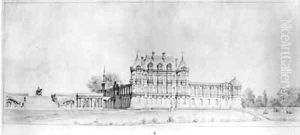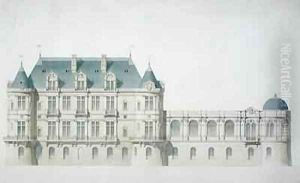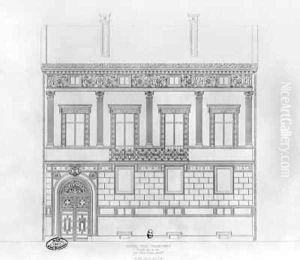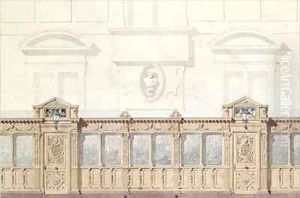Felix Louis Jacques Duban Paintings
Félix Duban was a French architect, born in Paris on October 14, 1798. He was a central figure in the architectural movement that later became known as the Beaux-Arts style, and he played a significant role in 19th-century French architecture. Duban was educated at the École des Beaux-Arts in Paris, where he was a student under the neoclassical architect Antoine-Laurent-Thomas Vaudoyer. In 1823, he won the prestigious Prix de Rome, which allowed him to study at the French Academy in Rome, the Villa Medici, for a period of five years.
During his time in Rome, Duban was exposed to the ancient and Renaissance architecture that would greatly influence his style and approach to design. After his return to Paris, he began to receive commissions that would establish his reputation. Duban's work is characterized by a clear, colorful, and eclectic style, incorporating elements from a wide range of historical styles and periods. He was part of the movement that eschewed the strict neoclassical approach that had dominated French architecture and sought instead to embrace a more varied and historically informed vocabulary.
One of his most significant projects was the restoration and completion of the Palais des Études at the École des Beaux-Arts in Paris, which had been started by his teacher Vaudoyer. Duban's work on the project, which spanned from 1830 to 1870, was crucial in shaping the future of architectural education, as his designs for the school's interior galleries and courtyards were widely admired for their beauty and innovation. In addition to his contributions to the École des Beaux-Arts, Duban was also responsible for the restoration of parts of the Château de Blois, a project that began in 1844 and continued until his death. His work at Blois is notable for its approach to historical accuracy and its influence on the emerging field of historical preservation.
Félix Duban's impact on French architecture extended beyond his designs and restorations. As a professor at the École des Beaux-Arts, he influenced a generation of architects who would continue to shape French and European architecture for decades to come. Duban's approach to teaching emphasized the importance of historical knowledge and the study of classical forms, while also encouraging innovation and individual expression. His legacy in architectural education is still felt today, as the principles he championed remain integral to the curriculum of many architectural schools.
Félix Duban died on October 8, 1870, in Bordeaux. His passing marked the end of a career that had a profound impact on the architectural landscape of France, both in terms of the built environment and architectural pedagogy. His restorative work also paved the way for modern practices in the field of historic preservation, and his teaching philosophy continues to inspire architects and students alike.



